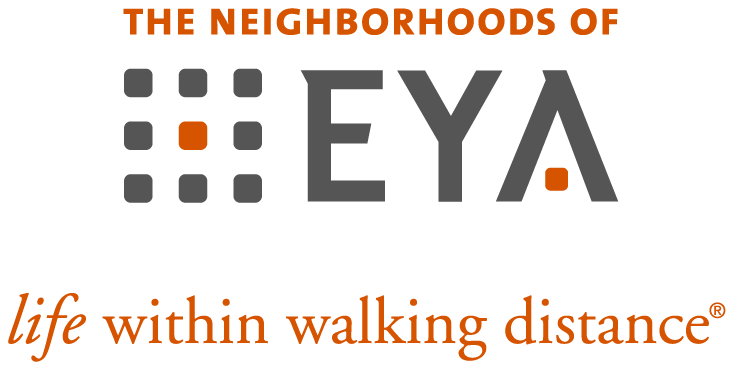3 Big Reasons to Live in a Walkable Community
By: EYA Homes on August 8th, 2017
Do you want a healthier, safer, and possibly happier lifestyle? Who wouldn’t. It’s why people consider making a move to a walkable community.
What Makes a Community Walkable?
A walkable community is more than just a place you can walk around; there are several criteria that define a walkable community. The Mid-America Regional Council outlined many of these differentiators for local governments looking to increase their walkable communities:
- Pedestrians are the highest priority throughout the community
- Roads are specifically designed to accommodate pedestrians, with their safety and comfort in mind
- Speed limits are set with a focus on the pedestrian activities that often take place in a given area
- In some instances, automobiles are eliminated entirely to encourage alternate modes of travel
To measure a community’s walkability, many residents, realtors, businesses, and local governments use the walk score methodology. You can look up your current neighborhood’s walk score to see if it’s a “Walker's Paradise” or “Car Dependent.” Next, let’s consider why many people want to live in this type of neighborhood.
If you need help deciding which new townhome or EYA neighborhood is right for you, send us a quick message. We’d be happy to help you make the best choice.
While enjoying increased popularity, walkable communities are not a new concept. Originally they formed in response to people’s needs and interests, and were developed organicially rather than planned by civic or business leaders.
Most city centers grew around features including a mix of residential and business/commercial properties, blended with services, retail, schools, places of worship, and recreation.
Today, homebuyers increasingly seek an ideal mix of walkability with modern design and conveniences found in a new construction home. Read on to learn three reasons why people want a truly walkable neighborhood.
1) Walkable Communities are Safer
Walkable communities are designed with pedestrians in mind, which makes these neighborhoods inherently safer. A pedestrian-friendly sidewalk and street design results in reduced traffic speeds, encourages residents to be more active outside their homes, and increases a neighborhood engagement that is believed to reduce crime.
Slower traffic speeds encourage drivers to be more alert and aware of their surroundings. With lower speed limits, drivers are more likely to see pedestrians and other obstacles, thereby reducing accidents. This is well understood. Still, you may wonder, “How is a walkable community safer from crime?”
The Safe Routes to School National Partnership champions what they call “crime prevention through environmental design” (CPTED). The way a community is designed can minimize opportunities for crime. Yes, the strategy behind a community plan can actually influence potential criminals. If streets, sidewalks, and parks are active with pedestrians, well-used and well-lit at night, criminals are far less likely to strike. With increased pedestrian activity, neighborhoods create safety in numbers, heightened awareness, and familiarity that help to build a stronger sense of community.
2) Walkable Communities Promote Health
There are numerous studies proving that walkable communities lead to healthier lifestyles.
The National Health and Nutrition Examination Survey established that residents living in more walkable communities with lower crime rates tend to walk more (surprise!). The analysis also found that these citizens tended to “have lower body mass indices (BMIs) than people in less walkable and more crime-prone areas, even after controlling for a variety of individual variables related to health.”
Furthermore, research from the University of Kansas’ Alzheimer’s Disease Center found that walkable neighborhoods may even improve citizens’ mental health.
The researchers compared people who lived in areas that required fewer turns to navigate the streets to those living in communities with more conventional intersecting paths and streets.They defined the latter phenomenon as “higher connectivity.”
The researchers found that those living in less-connected neighborhoods, such as suburban developments with long winding roads:
- Performed worse on baseline cognition tests
- Were more likely to see declines in attention and verbal memory
Another study conducted by the Lawrence Berkeley National Laboratory, Life Science Division found that walking briskly has some of the same benefits as running. Both help lower your risk of high blood pressure, high cholesterol, and diabetes. So forget planned runs – if you live in a walkable community and pick up the pace, you could even reduce your risk of heart disease and stroke.
3) Walkable Neighborhoods Create a Sense of Community
Researchers have found that when people have a stronger sense of community, they tend to feel more connected. A study by Carnegie Mellon student Brian Knudsen of Urban Innovation Analysis, Terry Clark of the University of Chicago, and Daniel Silver of the University of Toronto examines the connection between walkability, creativity, and civic engagement in the U.S., Canada, and France.
The researchers found that:
“Walking, the arts, and social-movement activism are not only separate processes. They enhance one another. Walking amidst the arts appears to heighten imaginative openness to new social and political possibilities, energizing [social movement organizations] activity more powerfully than walking on its own. Walking is important, but not all walking is the same, and when it occurs in locales with more arts activity, its impact on social movement organizations is greater.”
Walkable communities also tend to encourage more social interaction among residents, fostering closer, stronger relationships and engagement. As one of the world's longest studies, the Harvard Study of Adult Development, indicates that quality relationships are the greatest factor to influence your sense of happiness.
Leading a Happier Life in a Walkable Community
Living in a walkable community may have once been a “nice to have” for many families searching for a new home. However, with a spectrum of studies proving the numerous benefits of these communities, walkable neighborhoods have become "must haves" for many. This is why residential developers and local civic leaders are designing more of these neighborhoods.
Need help figuring out which townhome and walkable community is best for you and your family? We can help you choose your best option.


